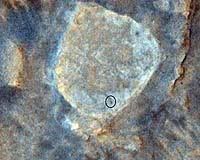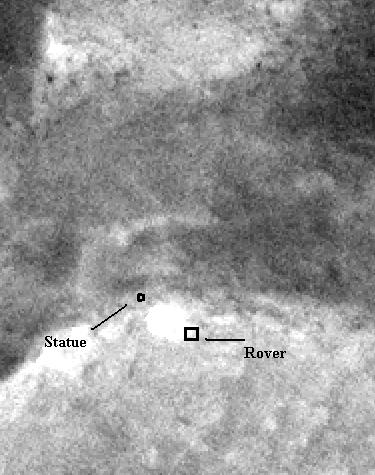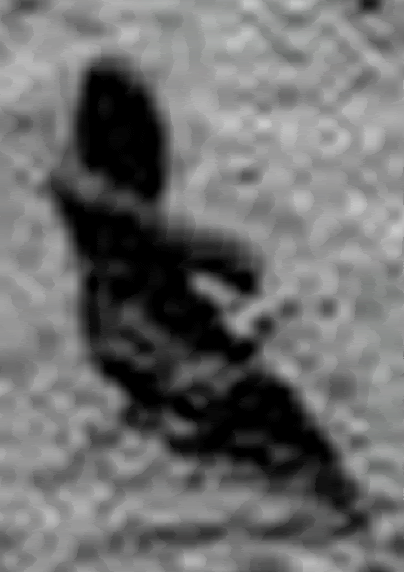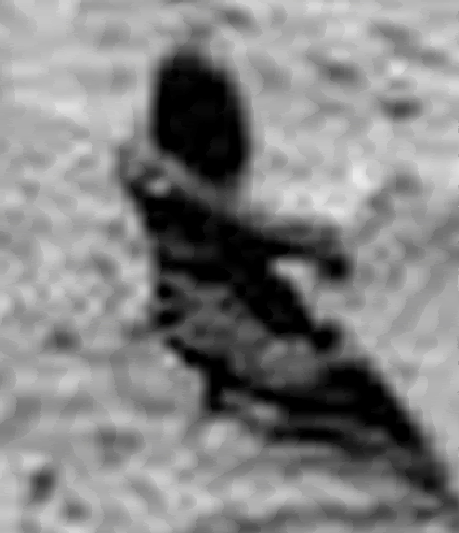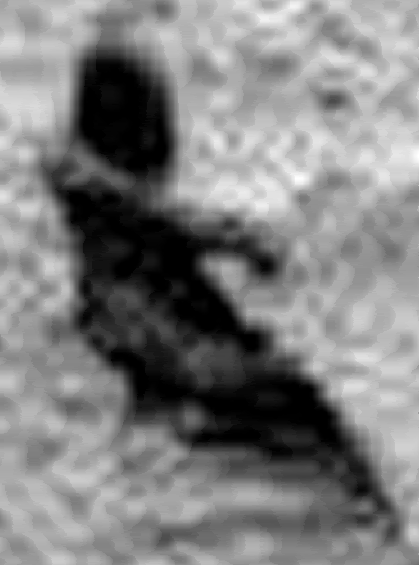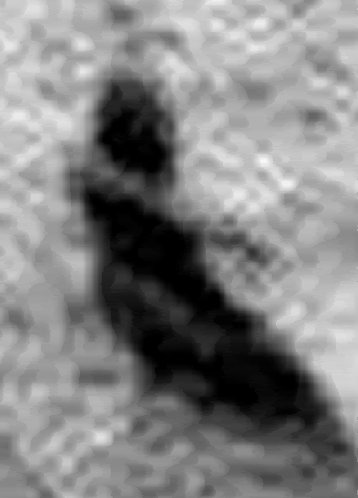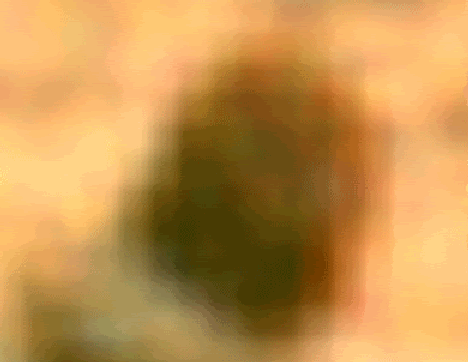- Thank you received: 0
Faces from the Chasmas
- neilderosa
-
- Offline
- Platinum Member
-

Less
More
17 years 2 months ago #20793
by neilderosa
Replied by neilderosa on topic Reply from Neil DeRosa
<blockquote id="quote"><font size="2" face="Verdana, Arial, Helvetica" id="quote">quote:<hr height="1" noshade id="quote">I've seen snowmen with more detail.<hr height="1" noshade id="quote"></blockquote id="quote"></font id="quote">
Interesting comparison.
Here's the colorized context image again (reduced).
And some background information on the image, courtesy of NASA.
<blockquote id="quote"><font size="2" face="Verdana, Arial, Helvetica" id="quote">quote:<hr height="1" noshade id="quote">Original Caption Released with Image:
NASA'S Mars Exploration Rover Spirit captured this westward view from atop a low plateau where Sprit spent the closing months of 2007.
After several months near the base of the plateau called "Home Plate" in the inner basin of the Columbia Hills range inside Gusev Crater, Spirit climbed onto the eastern edge of the plateau during the rover's 1,306th Martian day, or sol, (Sept. 5, 2007). It examined rocks and soils at several locations on the southern half of Home Plate during September and October. <u><b>It was perched near the western edge of Home Plate when it used its panoramic camera (Pancam) to take the images used in this view on sols 1,366 through 1,369 (Nov. 6 through Nov. 9, 2007).</b></u> With its daily solar-energy supply shrinking as Martian summer turned to fall, Spirit then drove to the northern edge of Home Plate for a favorable winter haven. The rover reached that northward-tilting site in December, in time for the fourth Earth-year anniversary of its landing on Mars. Spirit reached Mars on Jan. 4, 2004, Universal Time (Jan. 3, 2004, Pacific Standard Time). It landed at a site at about the center of the horizon in this image.
<u><b>This panorama covers a scene spanning left to right from southwest to northwest. The western edge of Home Plate is in the foreground, generally lighter in tone than the more distant parts of the scene. A rock-dotted hill in the middle distance across the left third of the image is "Tsiolkovski Ridge," about 30 meters or 100 feet from the edge of Home Plate and about that same distance across.</b></u> A bump on the horizon above the left edge of Tsiolkovski Ridge is "Grissom Hill," about 8 kilometers or 5 miles away. At right, the highest point of the horizon is "Husband Hill," to the north and about 800 meters or half a mile away.
This view combines separate images taken through Pancam filters centered on wavelengths of 753 nanometers, 535 nanometers and 432 nanometers. It is presented in a false-color stretch to bring out subtle color differences in the scene. [Image Credit:
NASA/JPL-Caltech/Cornell University]
<hr height="1" noshade id="quote"></blockquote id="quote"></font id="quote">
About "Home Plate"
<blockquote id="quote"><font size="2" face="Verdana, Arial, Helvetica" id="quote">quote:<hr height="1" noshade id="quote">The Mars Exploration Rover Spirit continues to investigate a layered feature called Home Plate. These deposits may contain the first known example of extraterrestrial phreatomagmatic eruptions. Home Plate, a roughly circular shaped plateau structure 2 to 4 m high and 90 m diameter, is located on the floor of the Inner Basin of the Columbia Hills [Squyres et al, 2007].<hr height="1" noshade id="quote"></blockquote id="quote"></font id="quote">
To be continued.
Interesting comparison.
Here's the colorized context image again (reduced).
And some background information on the image, courtesy of NASA.
<blockquote id="quote"><font size="2" face="Verdana, Arial, Helvetica" id="quote">quote:<hr height="1" noshade id="quote">Original Caption Released with Image:
NASA'S Mars Exploration Rover Spirit captured this westward view from atop a low plateau where Sprit spent the closing months of 2007.
After several months near the base of the plateau called "Home Plate" in the inner basin of the Columbia Hills range inside Gusev Crater, Spirit climbed onto the eastern edge of the plateau during the rover's 1,306th Martian day, or sol, (Sept. 5, 2007). It examined rocks and soils at several locations on the southern half of Home Plate during September and October. <u><b>It was perched near the western edge of Home Plate when it used its panoramic camera (Pancam) to take the images used in this view on sols 1,366 through 1,369 (Nov. 6 through Nov. 9, 2007).</b></u> With its daily solar-energy supply shrinking as Martian summer turned to fall, Spirit then drove to the northern edge of Home Plate for a favorable winter haven. The rover reached that northward-tilting site in December, in time for the fourth Earth-year anniversary of its landing on Mars. Spirit reached Mars on Jan. 4, 2004, Universal Time (Jan. 3, 2004, Pacific Standard Time). It landed at a site at about the center of the horizon in this image.
<u><b>This panorama covers a scene spanning left to right from southwest to northwest. The western edge of Home Plate is in the foreground, generally lighter in tone than the more distant parts of the scene. A rock-dotted hill in the middle distance across the left third of the image is "Tsiolkovski Ridge," about 30 meters or 100 feet from the edge of Home Plate and about that same distance across.</b></u> A bump on the horizon above the left edge of Tsiolkovski Ridge is "Grissom Hill," about 8 kilometers or 5 miles away. At right, the highest point of the horizon is "Husband Hill," to the north and about 800 meters or half a mile away.
This view combines separate images taken through Pancam filters centered on wavelengths of 753 nanometers, 535 nanometers and 432 nanometers. It is presented in a false-color stretch to bring out subtle color differences in the scene. [Image Credit:
NASA/JPL-Caltech/Cornell University]
<hr height="1" noshade id="quote"></blockquote id="quote"></font id="quote">
About "Home Plate"
<blockquote id="quote"><font size="2" face="Verdana, Arial, Helvetica" id="quote">quote:<hr height="1" noshade id="quote">The Mars Exploration Rover Spirit continues to investigate a layered feature called Home Plate. These deposits may contain the first known example of extraterrestrial phreatomagmatic eruptions. Home Plate, a roughly circular shaped plateau structure 2 to 4 m high and 90 m diameter, is located on the floor of the Inner Basin of the Columbia Hills [Squyres et al, 2007].<hr height="1" noshade id="quote"></blockquote id="quote"></font id="quote">
To be continued.
Please Log in or Create an account to join the conversation.
- neilderosa
-
- Offline
- Platinum Member
-

Less
More
- Thank you received: 0
17 years 2 months ago #4411
by neilderosa
Replied by neilderosa on topic Reply from Neil DeRosa
[continued from last post]
The Venus statue may indeed be quite small, one foot tall more or less. We have no objective way of knowing but we can guess by what is seen. If the "Tsiolkovski Ridge," is around 30 m from the western edge of Home plate, the rover may be near that distance again from the edge. The statue is off to the left in the composite panorama on the edge or ridge of Home Plate. Presumably the colorized composite had to be stretched and/or compressed in places in order for the raw data images to fit together seamlessly. This could distort intuitive impressions of distances, and hence the size of the statue must remain in question without more objective criteria. I found four relevant raw data images at the link for Spirit Rover.
marsrovers.jpl.nasa.gov/gallery/all/
They shed little light on the questions we have raised except to underscore them. In three of them, the statue seems more detailed than in the colorized composite, but the face is in shadow in all four while it has some light and detail however vague, in the colorized version. Are there other raw data images? Does NASA maintain acquisition parameters for these images but not publish them? I don't know. [Neil DeRosa]
West edge of Home Plate; west is up.
Raw data images
P2415R1M1
P2415L7M1
P2415L5M1
P2415L2M1
Colorized face of statue
The Venus statue may indeed be quite small, one foot tall more or less. We have no objective way of knowing but we can guess by what is seen. If the "Tsiolkovski Ridge," is around 30 m from the western edge of Home plate, the rover may be near that distance again from the edge. The statue is off to the left in the composite panorama on the edge or ridge of Home Plate. Presumably the colorized composite had to be stretched and/or compressed in places in order for the raw data images to fit together seamlessly. This could distort intuitive impressions of distances, and hence the size of the statue must remain in question without more objective criteria. I found four relevant raw data images at the link for Spirit Rover.
marsrovers.jpl.nasa.gov/gallery/all/
They shed little light on the questions we have raised except to underscore them. In three of them, the statue seems more detailed than in the colorized composite, but the face is in shadow in all four while it has some light and detail however vague, in the colorized version. Are there other raw data images? Does NASA maintain acquisition parameters for these images but not publish them? I don't know. [Neil DeRosa]
West edge of Home Plate; west is up.
Raw data images
P2415R1M1
P2415L7M1
P2415L5M1
P2415L2M1
Colorized face of statue
Please Log in or Create an account to join the conversation.
- tvanflandern
-
- Offline
- Platinum Member
-

Less
More
- Thank you received: 0
17 years 2 months ago #20520
by tvanflandern
Replied by tvanflandern on topic Reply from Tom Van Flandern
There are lots of oddly shaped shadows at the same scale, making it almost impossible to distinguish artifact from pareidolia in this instance. I see two possibilities besides the one you were pursuing, detail in the face.
(1) Get the Sun altitude and azimuth and determine if the local topography could be consistent with a pure shadow interpretation. Without that data, a shadow looks like a real possibility to me. Can you find a way to rule that out?
(2) Use the stereo view to look at the image in 3D to determine if it is one coherent whole, or perhaps composed of discrete parts. My quick glance suggested the possibility that the "head" might be a shadow on the crater floor instead of on the rim. But I did not take the time to verify this. -|Tom|-
(1) Get the Sun altitude and azimuth and determine if the local topography could be consistent with a pure shadow interpretation. Without that data, a shadow looks like a real possibility to me. Can you find a way to rule that out?
(2) Use the stereo view to look at the image in 3D to determine if it is one coherent whole, or perhaps composed of discrete parts. My quick glance suggested the possibility that the "head" might be a shadow on the crater floor instead of on the rim. But I did not take the time to verify this. -|Tom|-
Please Log in or Create an account to join the conversation.
- neilderosa
-
- Offline
- Platinum Member
-

Less
More
- Thank you received: 0
17 years 2 months ago #18597
by neilderosa
Replied by neilderosa on topic Reply from Neil DeRosa
<blockquote id="quote"><font size="2" face="Verdana, Arial, Helvetica" id="quote">quote:<hr height="1" noshade id="quote">There are lots of oddly shaped shadows at the same scale, making it almost impossible to distinguish artifact from pareidolia in this instance. I see two possibilities besides the one you were pursuing, detail in the face.
(1) Get the Sun altitude and azimuth and determine if the local topography could be consistent with a pure shadow interpretation. Without that data, a shadow looks like a real possibility to me. Can you find a way to rule that out?
(2) Use the stereo view to look at the image in 3D to determine if it is one coherent whole, or perhaps composed of discrete parts. My quick glance suggested the possibility that the "head" might be a shadow on the crater floor instead of on the rim. But I did not take the time to verify this. -|Tom|-<hr height="1" noshade id="quote"></blockquote id="quote"></font id="quote">
Thanks for your input. I hope someone will pursue these lines of evidence. My position has been quite consistent for sometime now. I do not think there is sufficient information or evidence to be reasonably certain about artificiality of this small statue-like object (discoverer unknown); although intuitively I lean toward artificiality, and would hope that NASA would be interested in trying to falsify artificiality by taking a new close-up in good lighting. To sum up on this subject I list those points for and against artificiality of the Venus statue:
Arguments favoring artificiality:
1- Trustworthy provenance; we can be quite certain that this object, which looks like a Venus statue, really exists and is where it is purported to be, and that the raw data images of it are not faked.
2- Elaborate pareidolia theory favors artificiality of the object.
3- There is abundant body detail including the head silhouette, corresponding to a human female, and the suggestion of facial detail, again corresponding to a human female, in the colorized image.
4- Given proven artificiality elsewhere on Mars weighs in favor of the possibility of art works or artifacts at different locations on Mars for reasons unknown to us as yet, including this small statue-like object.
And against:
1- Poor image resolution even at this close distance (within 100 feet) to the object.
2- Image was photographed from only one vantage point (incidence angle), so it is entirely possible that from another angle the object will look completely different, and thus prove to be a pareidolic rock formation.
3- Poor shading. We are tantalized yet again, but must assume an unfortunate coincidence which obscures the most important aspect of the object, namely its face. Although the body is fairly well lit, the head and face are in the dark in three raw data images. In the fourth raw data image the face has some lighting, but this is also the poorest resolution image.
4- We can not be sure that the "stretched" colorized composite is a realistic rendition of the originals.
5- A detailed image of the face with secondary features and / or of the body from a different angle would constitute valid <i>a priori</i> evidence for artificiality, but we don't have it, and may not see it any time soon.
[Neil DeRosa]
(1) Get the Sun altitude and azimuth and determine if the local topography could be consistent with a pure shadow interpretation. Without that data, a shadow looks like a real possibility to me. Can you find a way to rule that out?
(2) Use the stereo view to look at the image in 3D to determine if it is one coherent whole, or perhaps composed of discrete parts. My quick glance suggested the possibility that the "head" might be a shadow on the crater floor instead of on the rim. But I did not take the time to verify this. -|Tom|-<hr height="1" noshade id="quote"></blockquote id="quote"></font id="quote">
Thanks for your input. I hope someone will pursue these lines of evidence. My position has been quite consistent for sometime now. I do not think there is sufficient information or evidence to be reasonably certain about artificiality of this small statue-like object (discoverer unknown); although intuitively I lean toward artificiality, and would hope that NASA would be interested in trying to falsify artificiality by taking a new close-up in good lighting. To sum up on this subject I list those points for and against artificiality of the Venus statue:
Arguments favoring artificiality:
1- Trustworthy provenance; we can be quite certain that this object, which looks like a Venus statue, really exists and is where it is purported to be, and that the raw data images of it are not faked.
2- Elaborate pareidolia theory favors artificiality of the object.
3- There is abundant body detail including the head silhouette, corresponding to a human female, and the suggestion of facial detail, again corresponding to a human female, in the colorized image.
4- Given proven artificiality elsewhere on Mars weighs in favor of the possibility of art works or artifacts at different locations on Mars for reasons unknown to us as yet, including this small statue-like object.
And against:
1- Poor image resolution even at this close distance (within 100 feet) to the object.
2- Image was photographed from only one vantage point (incidence angle), so it is entirely possible that from another angle the object will look completely different, and thus prove to be a pareidolic rock formation.
3- Poor shading. We are tantalized yet again, but must assume an unfortunate coincidence which obscures the most important aspect of the object, namely its face. Although the body is fairly well lit, the head and face are in the dark in three raw data images. In the fourth raw data image the face has some lighting, but this is also the poorest resolution image.
4- We can not be sure that the "stretched" colorized composite is a realistic rendition of the originals.
5- A detailed image of the face with secondary features and / or of the body from a different angle would constitute valid <i>a priori</i> evidence for artificiality, but we don't have it, and may not see it any time soon.
[Neil DeRosa]
Please Log in or Create an account to join the conversation.
17 years 2 months ago #15091
by rderosa
Replied by rderosa on topic Reply from Richard DeRosa
<blockquote id="quote"><font size="2" face="Verdana, Arial, Helvetica" id="quote">quote:<hr height="1" noshade id="quote"><i>Originally posted by neilderosa: </i>Thanks for your input. I hope someone will pursue these lines of evidence. [Neil DeRosa]<hr height="1" noshade id="quote"></blockquote id="quote"></font id="quote">I would think that the person whose lines of evidence are at question here would be the one to pursue it. I can't imagine a scenario where some other person or persons unknown would pursue it. There are not many people out there who take this all that seriously, so it seems to me that it would be difficult to find someone who is even interested, let alone someone who is going to take another person's "evidence" and "pursue" it.
I suppose anything is possible, but logically you should be the one to prove or disprove your own case, and then present your results showing whether or not the results are consistent with your theory, or whether they falsify it. Tom's suggestions would probably be a good place to start.
rd
I suppose anything is possible, but logically you should be the one to prove or disprove your own case, and then present your results showing whether or not the results are consistent with your theory, or whether they falsify it. Tom's suggestions would probably be a good place to start.
rd
Please Log in or Create an account to join the conversation.
- neilderosa
-
- Offline
- Platinum Member
-

Less
More
- Thank you received: 0
17 years 2 months ago #20523
by neilderosa
Replied by neilderosa on topic Reply from Neil DeRosa
There has been some programming alteration of the text in some of my posts due to my habit of composing, and / or conducting spell checks in Microsoft Word, and then copying to the MRMB website. Apparently some of the MSW programming code is not compatible with the MB software. I'll correct some of the most recent occurrences. [ND]
Please Log in or Create an account to join the conversation.
Time to create page: 0.292 seconds


